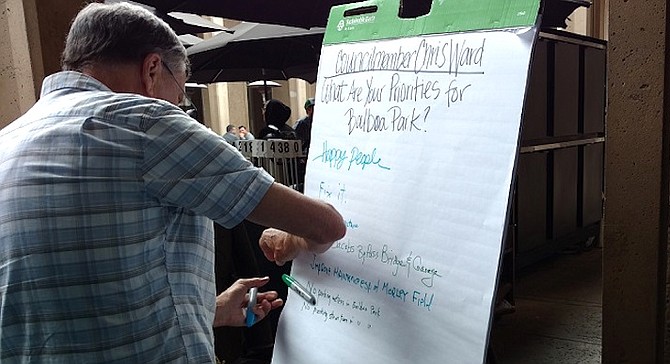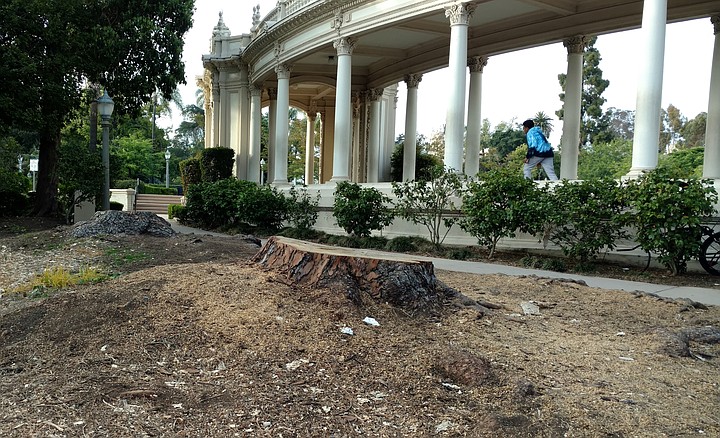 Facebook
Facebook
 X
X
 Instagram
Instagram
 TikTok
TikTok
 Youtube
Youtube

A crowd of about 100 gathered in an auditorium adjacent to the San Diego Museum of Art in Balboa Park on Tuesday evening (May 30) to discuss the state of the park's improvements and discuss priorities for making improvements, some decades overdue.

"We really have an opportunity to capitalize on to drive the next 30 years of improvements at the park," said city councilmember Chris Ward, who organized the meeting and whose 3rd district encompasses the park. "We know this is going to add up to a serious price tag, and we want to make sure that we properly recognize what the community's needs and wants are."
Landscape engineer Vicki Estrada, who's been involved with land use issues for years and was active in developing the last major master plan update in 1989, walked attendees through the park's history, which dates back to 1835 when the then-fledgling town of just 2300 residents dedicated 1400 acres to be used toward a grand city park.
"What we don't have yet is a true outdoor living room," said Estrada. "Most cities have these great outdoor plazas where people can gather."
Many ideas for the park, she said, have long languished due to a lack of funds — these include a plan to close a portion of Florida Drive to the park's east and freeway "lids" over Interstate 5 and Route 163 to heal "gashes" in the park's continuity created when freeways began to slice through parkland. Another scheme would have seen the creation of a linear park all the way to San Diego Bay, part of an incomplete 2004 revision to the master plan.
"There was a park-to-bay proposal on Park Boulevard, and we worked on some drawings. I wasn't allowed to put benches anywhere, because there was a fear that the homeless would use them," Estrada continued. "But if you're walking down there, by the way, you'll see blue arrows [which did end up getting installed along several blocks in the East Village] —those point to the water, green ones point to the park — no one ever catches that.
"A lot of other organizations in the park have been doing a lot of stuff — many of the improvements you see aren't just city projects," she continued, citing reforestation initiatives, restoration of the park's Botanical Building, and a revamp of a 6th Avenue playground as examples.
"We had drawings done for the 6th Avenue playground, the plans were approved, but they just withered away [at the city] because there was never any money for it."
Ward noted that an estimated unfunded work backlog of $300 million — $60 million in deferred maintenance, $100 million to finish items already identified in the park's master plan and another $76 million for a separate precise plan, $47 million for another plan for the park's east mesa, and $38 million to fund improvements that are already approved — was still an optimistic number.
"There are a couple of really high-priced things not included in the deferred maintenance," Ward told the group. "One is ADA improvements that are legally binding that we need to get done, the other is seismic retrofitting that needs to be done — that hasn't even been studied, with a cost laid out.
"These are lowballed numbers, as it is."
At the top of the list for seismic retrofits are the Museum of Art and Museum of Man, which opened in 1926 and 1915. The price to prepare those buildings alone for a quake along the nearby Rose Canyon fault could run into the tens of millions.
Still, the councilman sought suggestions from the audience as to how to prioritize the need for changes at the park, regardless of whether they were already embedded in one plan or another. Popular were calls to complete the deferred maintenance backlog before taking on any new projects and restoration of the Starlight Bowl concert venue.
"There is no statue of Balboa in Balboa Park, and it amazes me the amount of misinformation about Balboa that is passed around," said Jesus Benayas of the House of Spain in the park's House of Pacific Relations International College. "We should have a statue for the person for whom the park is named."
Judy Swink was among several who spoke up or scribbled notes on an easel set up outside the auditorium in opposition to the controversial plan to build a bridge bypassing the Plaza de Panama and diverting traffic to a paid-use parking garage – one speaker even suggested that the garage should be considered as a terrorist target.
"I was dismayed to see just today that two of the giant pine trees behind the Organ Pavilion have been chopped down, and the whole planting area has been pretty much cleared out," Swink said. "I'd like to know why, because it's my understanding that the Jacobs plan is on hold pending clarification of litigation that's already in place, and I'm disturbed if they're taking down these trees in anticipation of that plan going forward."
Ward's office plans to host another meeting with park supporters sometime in July after collecting further comment and identifying the most pressing budgetary concerns.


A crowd of about 100 gathered in an auditorium adjacent to the San Diego Museum of Art in Balboa Park on Tuesday evening (May 30) to discuss the state of the park's improvements and discuss priorities for making improvements, some decades overdue.

"We really have an opportunity to capitalize on to drive the next 30 years of improvements at the park," said city councilmember Chris Ward, who organized the meeting and whose 3rd district encompasses the park. "We know this is going to add up to a serious price tag, and we want to make sure that we properly recognize what the community's needs and wants are."
Landscape engineer Vicki Estrada, who's been involved with land use issues for years and was active in developing the last major master plan update in 1989, walked attendees through the park's history, which dates back to 1835 when the then-fledgling town of just 2300 residents dedicated 1400 acres to be used toward a grand city park.
"What we don't have yet is a true outdoor living room," said Estrada. "Most cities have these great outdoor plazas where people can gather."
Many ideas for the park, she said, have long languished due to a lack of funds — these include a plan to close a portion of Florida Drive to the park's east and freeway "lids" over Interstate 5 and Route 163 to heal "gashes" in the park's continuity created when freeways began to slice through parkland. Another scheme would have seen the creation of a linear park all the way to San Diego Bay, part of an incomplete 2004 revision to the master plan.
"There was a park-to-bay proposal on Park Boulevard, and we worked on some drawings. I wasn't allowed to put benches anywhere, because there was a fear that the homeless would use them," Estrada continued. "But if you're walking down there, by the way, you'll see blue arrows [which did end up getting installed along several blocks in the East Village] —those point to the water, green ones point to the park — no one ever catches that.
"A lot of other organizations in the park have been doing a lot of stuff — many of the improvements you see aren't just city projects," she continued, citing reforestation initiatives, restoration of the park's Botanical Building, and a revamp of a 6th Avenue playground as examples.
"We had drawings done for the 6th Avenue playground, the plans were approved, but they just withered away [at the city] because there was never any money for it."
Ward noted that an estimated unfunded work backlog of $300 million — $60 million in deferred maintenance, $100 million to finish items already identified in the park's master plan and another $76 million for a separate precise plan, $47 million for another plan for the park's east mesa, and $38 million to fund improvements that are already approved — was still an optimistic number.
"There are a couple of really high-priced things not included in the deferred maintenance," Ward told the group. "One is ADA improvements that are legally binding that we need to get done, the other is seismic retrofitting that needs to be done — that hasn't even been studied, with a cost laid out.
"These are lowballed numbers, as it is."
At the top of the list for seismic retrofits are the Museum of Art and Museum of Man, which opened in 1926 and 1915. The price to prepare those buildings alone for a quake along the nearby Rose Canyon fault could run into the tens of millions.
Still, the councilman sought suggestions from the audience as to how to prioritize the need for changes at the park, regardless of whether they were already embedded in one plan or another. Popular were calls to complete the deferred maintenance backlog before taking on any new projects and restoration of the Starlight Bowl concert venue.
"There is no statue of Balboa in Balboa Park, and it amazes me the amount of misinformation about Balboa that is passed around," said Jesus Benayas of the House of Spain in the park's House of Pacific Relations International College. "We should have a statue for the person for whom the park is named."
Judy Swink was among several who spoke up or scribbled notes on an easel set up outside the auditorium in opposition to the controversial plan to build a bridge bypassing the Plaza de Panama and diverting traffic to a paid-use parking garage – one speaker even suggested that the garage should be considered as a terrorist target.
"I was dismayed to see just today that two of the giant pine trees behind the Organ Pavilion have been chopped down, and the whole planting area has been pretty much cleared out," Swink said. "I'd like to know why, because it's my understanding that the Jacobs plan is on hold pending clarification of litigation that's already in place, and I'm disturbed if they're taking down these trees in anticipation of that plan going forward."
Ward's office plans to host another meeting with park supporters sometime in July after collecting further comment and identifying the most pressing budgetary concerns.
Comments